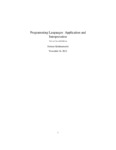Học liệu mở OER: Recent submissions
Now showing items 801-820 of 933
-
Information Systems for Business and Beyond
(The Saylor Foundation, 2014)Chapter 1: What Is an Information System? Chapter 2: Hardware. Chapter 3: Software. Chapter 4: Data and Databases. Chapter 5: Networking and Communication. Chapter 6: Information Systems Security. Chapter 7: Does IT Matter? ... -
How to Think Like a Computer Scientist: Learning with Python
(Green Tea Press, 2008)Chapter 1: The way of the program. Chapter 2: Variables, expressions and statements. Chapter 3: Functions. Chapter 4: Conditionals and recursion. Chapter 5: Fruitful functions. Chapter 6: Iteration. Chapter 7: Strings. ... -
How to Think Like a Computer Scientist: Think Java
(Green Tea Press, 2012)Chapter 1 The way of the program. Chapter 2 Variables and types. Chapter 3 Void Methods. Chapter 4 Conditionals and recursion. Chapter 5 GridWorld: Part One. Chapter 6 Value methods. Chapter 7 Iteration and loops. ... -
Business Information Systems: Design an App for That
(The Saylor Foundation, 2011)Chapter 1: Information Systems in Your Life: Types of Systems and Careers. Chapter 2: Information Systems to Enhance Business: Business Process Redesign. Chapter 3: Professionalism in Deliverables: Principles of Graphic ... -
Digital Circuit Projects: An Overview of Digital Circuits Through Implementing Integrated Circuits
(The Cupola, 2014)Chapter 1 Before you start. Chapter 2 Overview of a Central Processing. Chapter 3 Getting started. Chapter 4 Gates. Chapter 5 Associative Boolean operators. Chapter 6 Adders. Chapter 7 Decoders. Chapter 8 Multiplexers. ... -
Foundations of Computation
(Department of Mathematics and Computer Science, 2011)Foundations of Computation is a free textbook for a one-semester course in theoretical computer science. It has been used for several years in a course at Hobart and William Smith Colleges. The course has no prerequisites ... -
The Little Book of Semaphores
(Green Tea Press, 2008)Chapter 1 Introduction. Chapter 2 Semaphores. Chapter 3 Basic synchronization patterns. Chapter 4 Classical synchronization problems. Chapter 5 Less classical synchronization problems. Chapter 6 Not-so-classical problems. ... -
Think Python: How to Think Like a Computer Scientist
(Green Tea Press, 2012)Chapter 1: The way of the program. Chapter 2: Variables, expressions and statements. Chapter 3: Functions. Chapter 4: Case study: interface design. Chapter 5: Conditionals and recursion. Chapter 6: Fruitful functions. ... -
The Missing Link: An Introduction to Web Development and Programming
(Open SUNY Textbooks, 2014)Chapter 1: Brief History of the Internet. Chapter 2: Current Trends. Chapter 3: Web Servers. Chapter 4: Network Basics. Chapter 5: Website Design. Chapter 6: Development. Chapter 7: Markup Languages. Chapter 8: Creating ... -
Spatial Thinking in Planning Practice: An Introduction to GIS
(Portland State University Library, 2014)Preface. Chapter 1: Defining a Geographic Information System. Chapter 2: Coordinate Systems and Projecting GIS Data. Chapter 3: Topology and Creating Data. Chapter 4: Mapping People with Census Data. Chapter 5: Lying with ... -
Think Complexity
(Green Tea Press, 2012)This book is about complexity science, data structures and algorithms, intermediate programming in Python, and the philosophy of science: Data structures and algorithms: A data structure is a collection that contains data ... -
Open Data Structures: An Introduction
(Au Press, Athabasca University, 2013)Chapter 1. Introduction. Chapter 2. Array-Based Lists. Chapter 3. Linked Lists. Chapter 4. Skiplists. Chapter 5. Hash Tables. Chapter 6. Binary Trees. Chapter 7. Random Binary Search Trees. Chapter 8. Scapegoat Trees. ... -
Operating Systems and Middleware: Supporting Controlled Interaction
(Gustavus Adolphus College, 2011)Chapter 1: Introduction. Chapter 2: Threads. Chapter 3: Scheduling. Chapter 4: Synchronization and Deadlocks. Chapter 5: Atomic Transactions. Chapter 6: Virtual Memory. Chapter 7: Processes and Protection. Chapter 8: Files ... -
Programming Languages: Application and Interpretation
(Brown University, 2012)Chapter 1: Introduction. Chapter 2: Everything (We Will Say) About Parsing. Chapter 3: A First Look at Interpretation. Chapter 4: A First Taste of Desugaring. Chapter 5: Adding Functions to the Language. Chapter 6: From ... -
Physical Modeling in MATLAB
(Green Tea Press, 2014)Chapter 1: Variables and Values. Chapter 2: Scripts. Chapter 3: Loops. Chapter 4: Vectors. Chapter 5: Functions. Chapter 6: Zero-finding. Chapter 7: Functions of vectors. Chapter 8: Ordinary Differential Equations. Chapter ... -
Java, Java, Java: Object-Oriented Problem Solving
(Pearson Education, Inc, 2012)Computers, Objects, and Java. Java Program Design and Development. Objects: Defining, Creating, and Using. Methods: Communicating with Objects. Input/Output: Designing the User Interface. Java Data and Operators. Control ... -
Algorithms and Data Structures With Applications to Graphics and Geometry
(The Global Text Project, 2011)Part I: Programming environments for motion, graphics, and geometry. Chapter 1: Reducing a task to given primitives: programming motion. Chapter 2: Graphics primitives and environments. Chapter 3: Algorithm animation. Part ... -
GIMP 2.8 plus
(2013)Working on your photographs in GIMP, or any photo editor, is known as post processing (PP). To enable you to create stunning images you need to know how to use the tools in GIMP. The tools in GIMP are amazingly easy to ... -
Industrial emissions Directive EPR Guidance on Part A installations
(2013)Chapter II of the industrial emissions Directive applies an integrated environmental approach to the regulation of certain industrial activities. This means that emissions to air, water (including discharges to sewer) and ... -
Owasp testing guide
(2006)The problem of insecure software is perhaps the most important technical challenge of our time. Security is now the key limiting factor on what we are able to create with information technology. At The Open Web Application ...




















